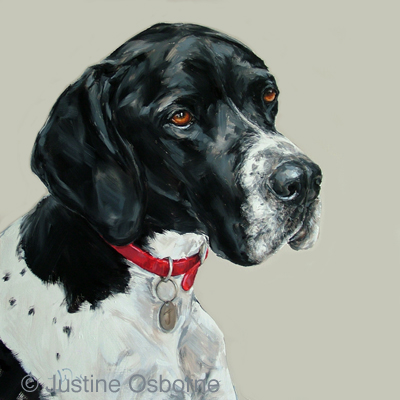
As passengers in a car driving down a country road recently, we idly watched the landscape roll past our window. Modest homes on acreage dotted the countryside, trees and bushes whirred past, and the road was a gray ribbon before us. Suddenly, our eye was caught by the animation of several people standing around a pickup truck in a front yard. At 40 mph, we had only seconds to form the impression that they were discussing the truck, or maybe it was something in the truck bed, but it doesn’t matter because it was the dog standing with them that made us sit up straight. We had but a moment to take in the dog’s information, but we got what we needed in a fraction of the time.
His color, his height, but especially that head, telegraphed in an instant that this was a Pointer. He was, to our eye, magnificent. Maybe he was a show dog, but if impressions made in a nanosecond can be relied upon, surely the dog had field experience. We’ll never know for sure, but that’s the thing about purebred dogs, particularly ones bred with care, intelligence, and respect: You know it when you see it: You’re looking at something special.
David Hancock writes in Gundogs that unless one is aware of the aspirations and philosophies of the pioneers in each gundog breed, one can’t appreciate these dogs of today. He adds that, “gundogs were selectively breed not as hearthrugs, but as shooting field assistants, and developed over centuries for function.”
If one is to believe that Pointers originated with the Spanish Pointer (and some sources challenge that), one will find interesting that the Spanish Pointer was said to be an accurate worker, but slow. This was okay at a time when old-fashioned flintlock guns were all a hunter had. Loading time was slow, and the guns were prone to misfire in wet weather. As guns modernized, however, the pace of hunting sped up, and a dog with more speed was needed. In their book, The Pointer, authors, Kitty Edmondson and Cicely Robertshaw wrote, “…with the Englishman’s flair for breeding excellent livestock, work was done on the raw material already obtained to create the pointer as it is known today. It was adapted, blended and vastly improved. It is thought that this was done by selective breeding and not by crossing. There is evidence through portraits that pointers had been altogether changed by the year 1800 which was when the “pointer” came to be the name used for the breed. It had taken just 100 years of careful breeding and selection to bring the pointer to perfection with the added invention of “backing”, which is the co-operation in work of two or more dogs.”
That’s what I saw at 40 mph.
Pointer by Justine Osborne
www.paintmydog.co.uk/gallery_pet_portraits.htm
www.etsy.com/shop/paintmydog
